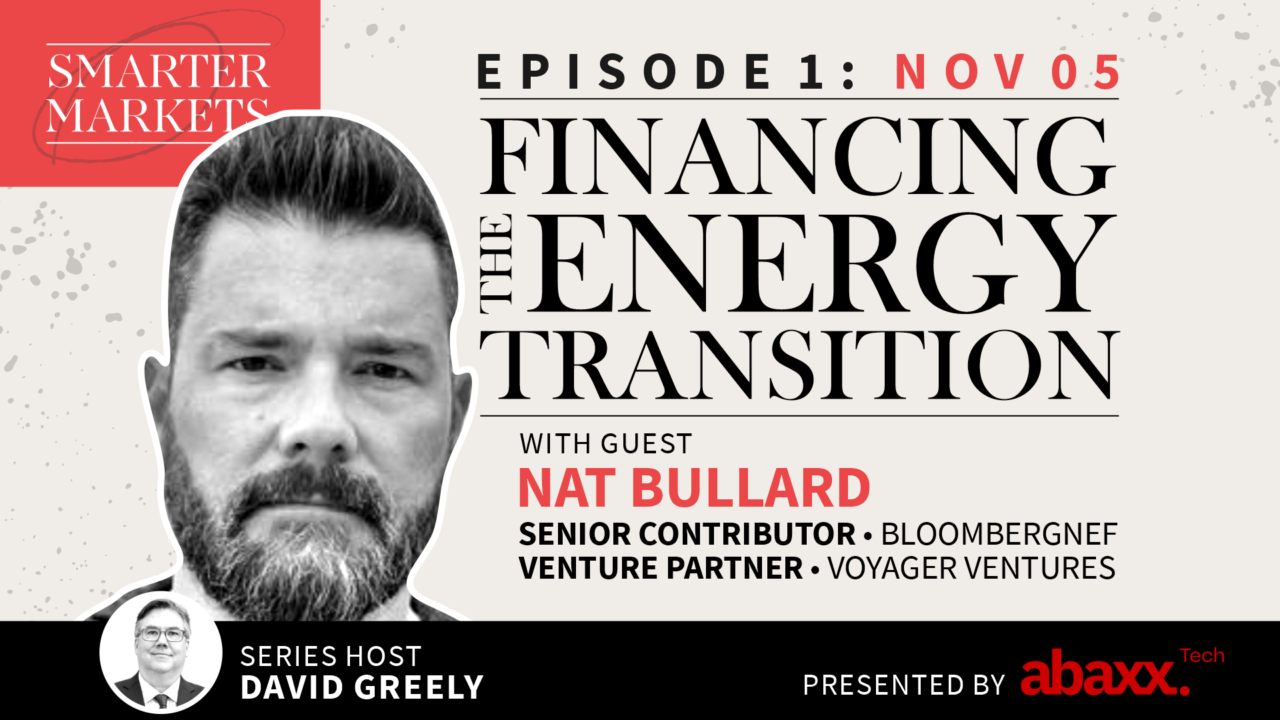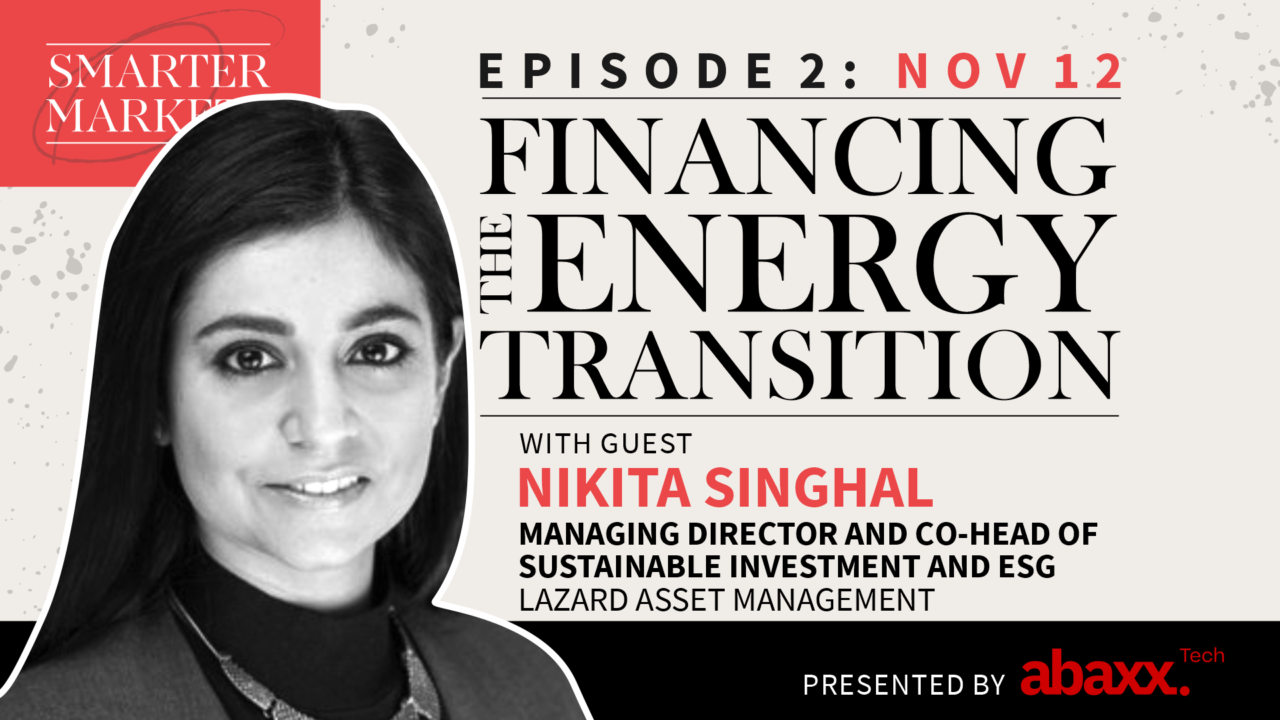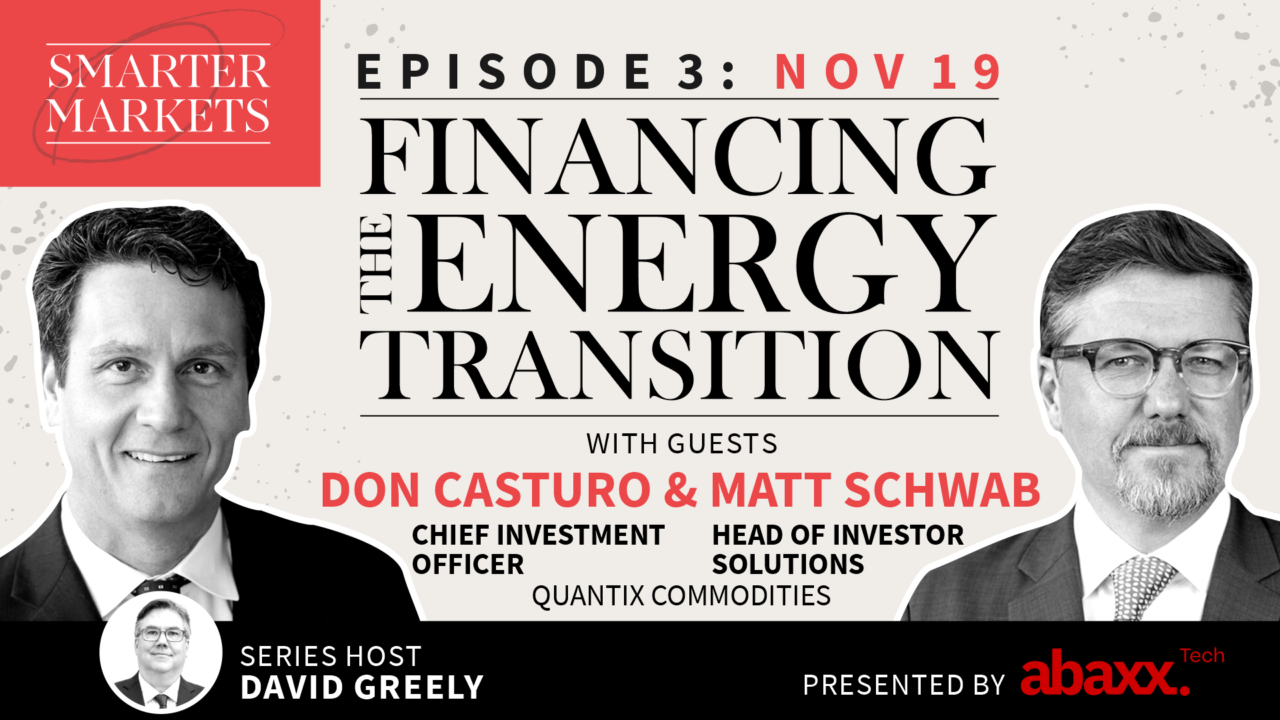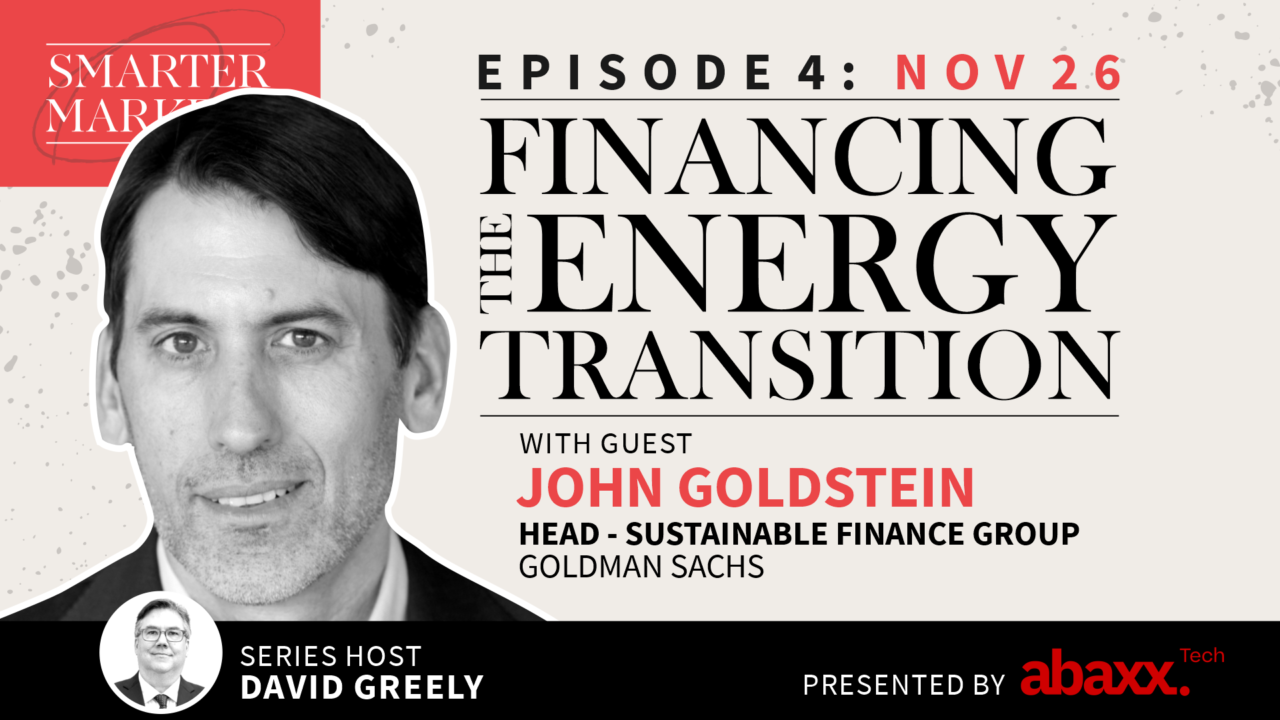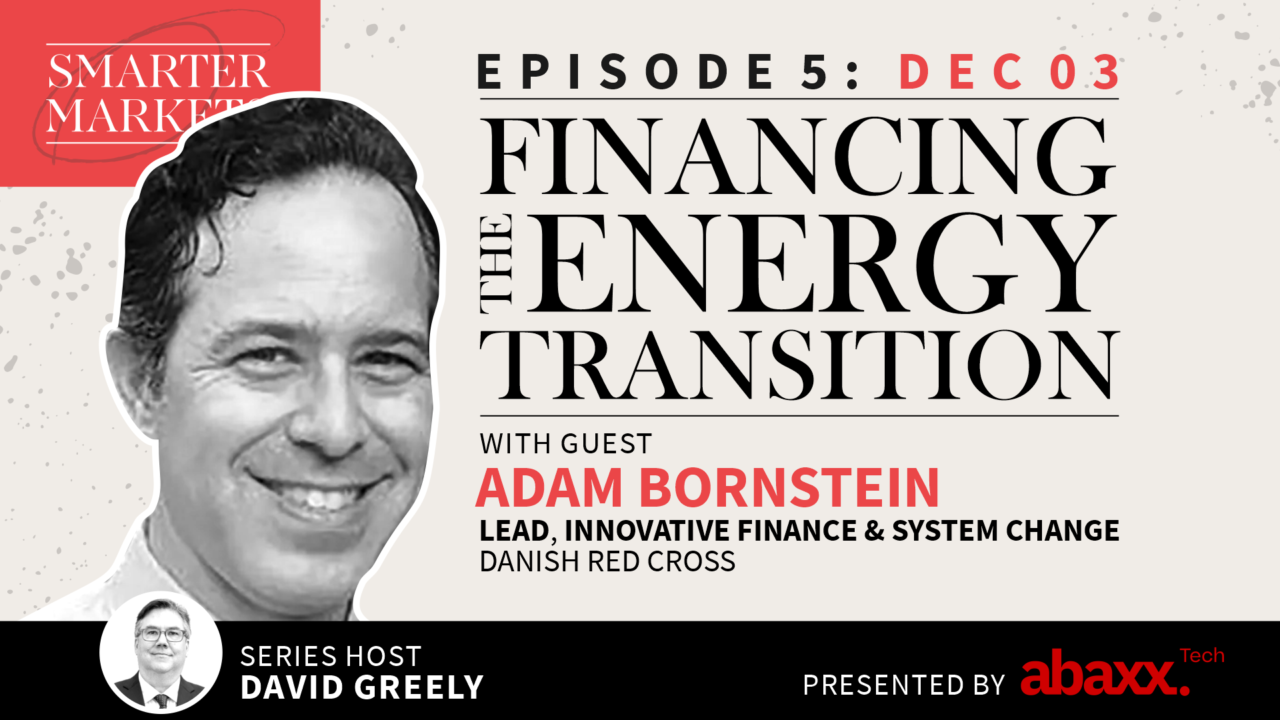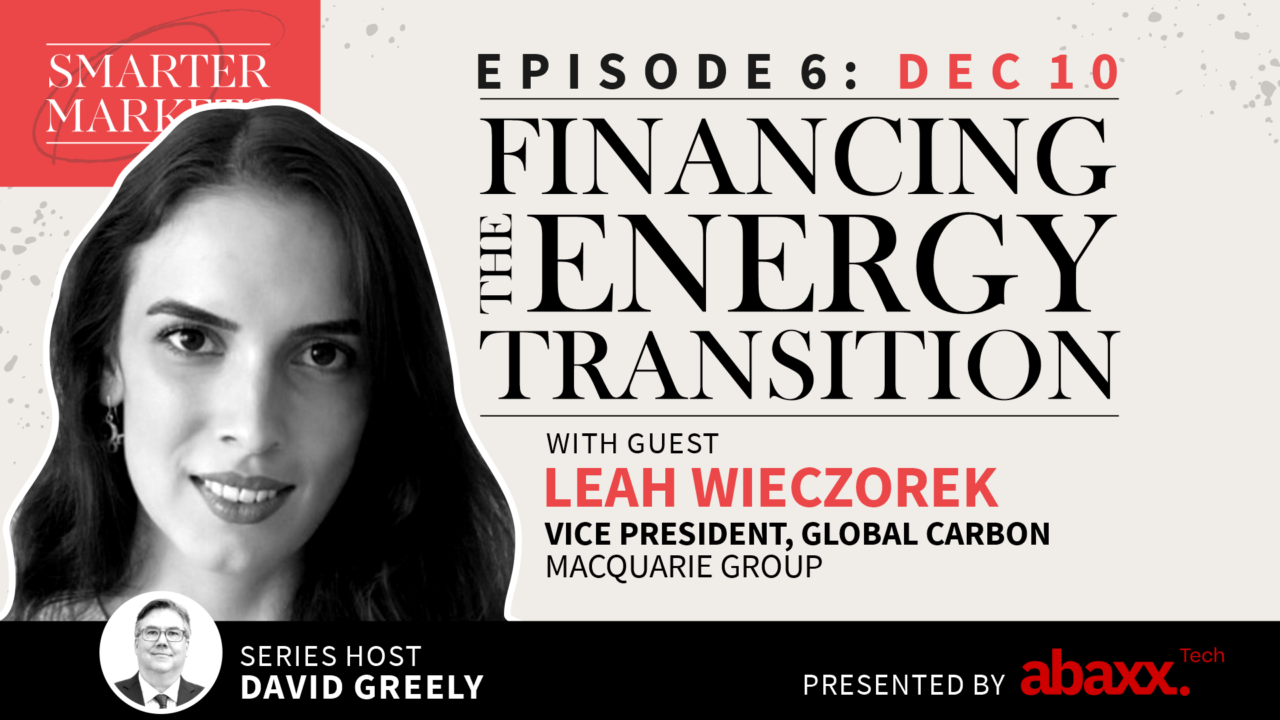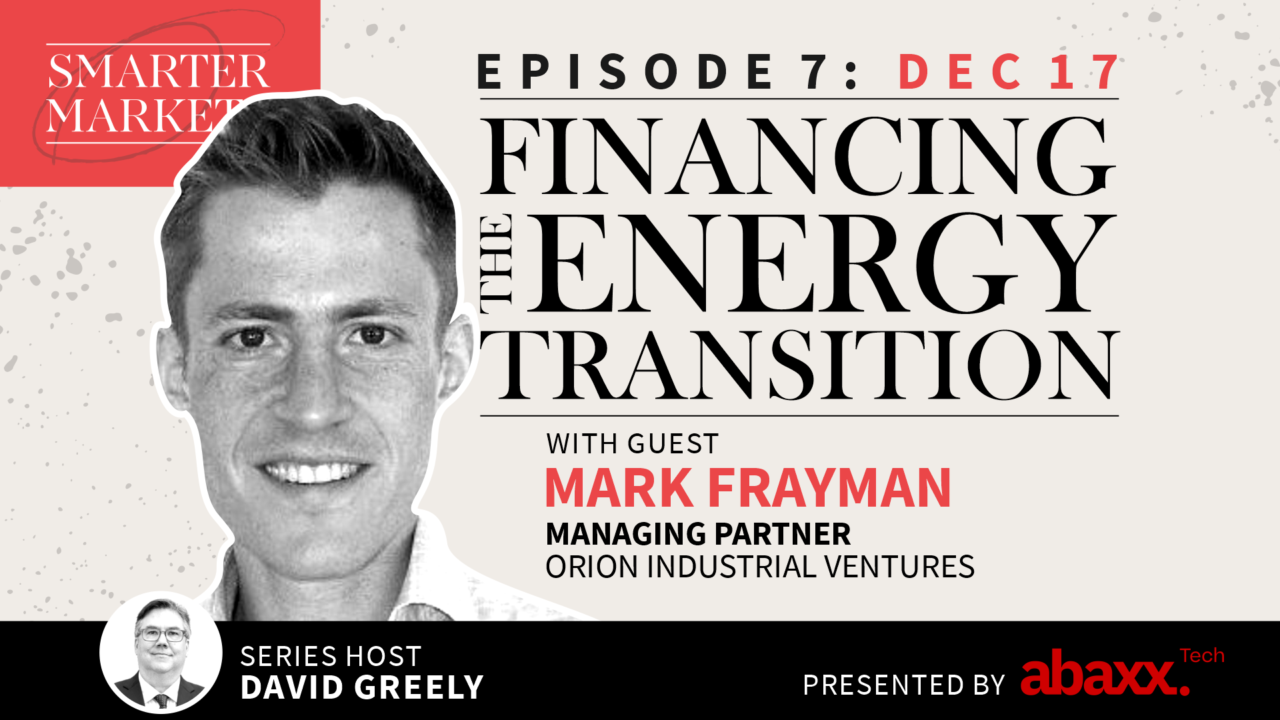We kick off our new series, Financing the Energy Transition, with Nat Bullard, Senior Contributor at BloombergNEF and a Venture Partner at Voyager Ventures. Nat writes weekly for Bloomberg Green on energy, transport, technology, climate, and finance. We start our new series by exploring with Nat the size of the investment that’s happening in the energy transition, where it’s coming from, and where it’s going to.
Hosted By
Episode Q&A
The following Q&A is created using slightly edited excerpts from the episode transcript, optimized for readability. Download full transcript.
NB: Certainly, let’s start with the scope and scale. Last year was about $750 billion, give or take, of investment in the energy transition. The investment went into power generation, renewables, electrified transport, and in a fairly long tail of other things such as hydrogen, heat, some sort of circular economy-related investment, and even nuclear power goes into that category. It has grown significantly over time. When I began doing this, it was more in the range of about $50 billion mid-2000s and, late 2000s. Now, we’re at about $4 trillion invested over the last 15 years or so, and it’s becoming a significant number. I think what’s important to do is to separate it into a couple of planes.
NB: The first is how much of that money is flowing into renewable power versus everything else. Renewable power has been bouncing around $400 billion for several years. It has hit a plateau, at least in the meantime, not necessarily in a bad way, and I’ll get to that. On the other hand, is approaching $300 billion a year, almost entirely electric vehicles. There’s also a small component underneath that of energy storage, and then all of that stuff is more in the range of about $100 billion in total. It’s not an insignificant number, but it needs to grow substantially if we want to do a deep decarbonization. Let’s think of it as an energy transition set of strategies in companies and towards real decarbonization of the global economy. You probably want to triple or even quadruple the top line of all those things.
NB: You’re going to need like 2.7x times more renewables, like 3x times more transport, and you’re going to need almost 10x times more of everything else that has historically been very difficult to do for technical reasons, specifically how to decarbonize steel, cement production, the electrification of heat, and other things of that nature. So that’s where the numbers go. Where it comes from is also worth looking at because you see a lot of attention to the early-stage elements of capital raising. So that’s like climate technology at the venture stage; private equity is about $50 billion yearly. You look at the activity in specs, pipe deals, and IPOs, and that’s the year the market is fairly active, but $110 billion. Equity at the company level flows into most of what’s happening in these different sectors. But two things are important to note. One is that almost all the money finances assets by financing the physical build of something, and two, most of that follows a fairly established project finance modality. So you’ve got a component of equity, a much larger component of debt, and that’s how long-dated assets with fixed contracts get built. So hopefully, that sketches a little bit about where it goes, but also how it goes in terms of flows into energy transition and decarbonization.
NB: It’s roughly about $9 out of every $10 in the investment realm for these assets is going towards building something; it’s going towards creating an asset that goes into the ground. That’s where most of the capital flows. And about half of it is going towards just renewable power generation; within that, almost all of it is going to wind and solar. So we’ve got a continually narrowing funnel regarding where money is typically going. What’s interesting about that is that figures are tapping out, which is not necessarily bad. In the long run, you want that number to be probably in the order of more than a trillion dollars a year. The declines we’ve seen have been this sort of combination, the triangulation of the falling capital cost of assets and money deployed. So you’re getting more out of every dollar deployed, which means that even if you have relatively flat or not hugely growing dollars in terms of deployment, the dollars invested instead, you see more assets deployed for that same money.
NB: So transport sort of quasi-fixed asset, in this case, they’re at least longer dated than consumer packaged goods or white goods. It transports where things are taking off and to game out at what point we would have more dollars invested in transportation than investing in clean energy. It’s fairly elastic depending upon the demand for electric vehicles, but we’re probably not far off in a year or two, maybe three before most of the dollars that are flowing are going into EVs and some of the related energy storage investment that goes with it. As far as where we’re probably not devoting enough, the early stage of things that were considered kind of science experiment or maybe science fiction level decarbonization is where we need to see more money if we want to see a lot of activity.
NB: And that’s what you would call hard-to-abate sectors. So that’s things like cement production chemicals, steel, aluminum production, places where you start to run into chemistry problems, not just physics problems, where you have molecular balances that you have to maintain, where you have incredibly high needs for heat and the quality of that heat, things like that. There’s another area, and this is becoming very apparent right now in Europe in the current series of crises kicked off by Russia’s invasion of Ukraine, which is in the heat of all sorts as something that needs to be decarbonized. Some of it is as prosaic is just replacing the home boiler with a heat pump. Other elements of it are going much further into industrial heat production, which is an extremely big proportion of global energy demand, but it’s also a very demanding portion of demand like you need to hit certain qualities of heat for certain durations with certain stability in ways that really cannot be converted into intermittency or variability. And so that’s where structurally we need much more investment to come.
NB: It’s a really good question. It’s like running a theme for anybody investing in climate, specifically, to look at a portfolio, asset, or company business model and verify whether this business is a climate investment. So the venture landscape is very healthy in terms of active fundraising. There’s a great deal of inbound interest from founders, and there’s a lot of limited partnership interest, which is where you want to be if you’re on the front and sharp end of things; there’s plenty of interest in creating new technologies addressing these challenging questions.
NB: What’s important is that we’re starting to see the money that gets laddered on top of that; to step these assets from experiment lab bench to massive deployments. Such things as Brookfield or Copenhagen Infrastructure Partners launching an energy transition fund; it’s something sort of the deployment capital for the long-run of building assets that one way or another are going to decarbonize; you’ve got interested from sovereign funds to Masek, in particular, has a big play here; in addressing not just challenges around infrastructure, but even increasingly challenges around things such as recycling or even trying to decarbonize or demethanizer rather the production of rice, which is both, a huge source of emissions and a huge source of calories in particular in Southeast Asia. And then you’ve got things such as the loan programs office at the Department of Energy here, which has been revivified, at scale, thanks to both the activities of its director and the new funding that has come from it the Inflation Reduction Act.
NB: So you’re starting to see money capable of carrying something from an idea to gigaton scale deployment, moving through steps and phases of capital in various tranches with various risk appetites, with various abilities to de-risk those technologies as time goes on. What I wrote in my piece that is important to mention is that if you want to address something as a climate investment, then it needs to, as a first principle, talk about its climate benefit, and that probably is in the range of what emissions is it avoiding, what process is it improving to what degree that we can measure in a climate way, and what kind of scale does it hope to achieve. So I think that’s a very important thing to put in because otherwise, we have the potential for looseness in defining whether or not something counts as climate. After all, if it in any way has something to do with emissions, you could consider it to be a climate investment. If we’re going to call all these new pools of capital when their investment approach is a climate investment approach, then it needs to address that element of what those companies intend to do.
NB: So there’s a series of different things that we can talk about for reducing carbon, one is probably the simplest to measure but is also one of the hardest to do, which is build a physical system that withdraws atmospheric carbon dioxide and one form, or another secures it on an ideally multi-century timeline so that it no longer enters the atmospheric carbon cycle. It’s relatively easy to measure, tough to do, and if it can be done, it’s generally quite expensive. Then there would be something like using a natural carbon sink such as afforestation or reforestation, wherein you can measure the uptake of carbon into the living things, into wood biomass, and with some assumptions, make the case that it’s absorbed this much carbon.
NB: Now that, unfortunately, can be highly contingent upon things outside the developer’s control, such as a drought and a wildfire that causes that ostensibly sunk carbon to go back up and smoke. And then there is probably the next phase looking at what in the UN language they would’ve called additionality, more or less, which is if I am building an offshore wind farm in the North Sea. What is the counterfactual to that? What would’ve happened otherwise to create that same 200-gigawatt hour of power per year? You would probably look at the grid and assess it as a delta based on that. So the grid is a small percentage of coal; it’s a lot of nuclear, natural gas, and renewables. So you would be evaluating it based on what otherwise would’ve happened in this counterfactual fashion.
NB: In the early stage, there is inherently an interest in things that can grow and scale quickly. So there’s interest in process improvements, a lot of interest in software that directly impacts operating systems. There’s also interest, frankly, in software as software. So things such as accounting or management of flows and carbon flows and things like that. So that’s within the realm of traditional venture scaling up a bit; there’s a lot of interest in relatively light infrastructure, the endpoint infrastructure of advanced transportation and energy storage wherein there’s a play that has a technological basis to it or a specific business model approach. Interestingly, we see quite a lot of funding interest at the institutional level now for things such as nuclear. We do not see enough interest because it’s highly contingent on policy, regulation, planning, and permission in transmission and building a connective network that will bring all of this new capacity to the market.
NB: Another area attracting interest and needs to attract a lot more is the intersection of climate and food, and agriculture. This part of the global emissions pie is very hard to address. It’s very highly distributed, and that data is not necessarily great. It is mission-critical to get it right to make sure that things are edible and sustainable, and so we’re beginning to see a lot of interest there, but I think it’s still fairly nascent. You could argue that some synthetic protein in the meats up where the meat substitute foods that we’ve seen are in one way or another something climate-related because they’re very directly avoiding the emissions that would come from a similar quantum of ground beef or of ground pork. But there’s much more to do and many more things to address.
NB: No, this is a really important thing for us to query a little bit, and I always start by saying that, if we were to build brand new risk screens today, knowing what we know and with the data we have available, would we somehow group environmental things that are inherently measurable with social things that are harder to measure and not necessarily as related with governance, which in a sense should be a component of all good corporate operations and the answer is that I don’t think that we necessarily would. I think we would be atomizing these into separate groups. It’s very complex to try to analyze all of these things together. It leaves apparent climate-related risk screening one way or another, grouped in with stuff that can become quite a bit of a political football.
NB: And that is where you find institutional fund managers in this challenging position. They could be set up in one element, a very rigorously defined asset and infrastructure investment thesis that doesn’t need ESG within it to exist at all. It’s simply going to have risk-adjusted returns above whatever baseline they’re assuming. It happens to be invested in things that are largely decarbonization related versus all the other activity that it might be measuring that is far more social and contentious, certainly, publicly. It would benefit in a way to sort of have these atomized again so that this is a fund that isn’t predicated upon ESG, it’s simply predicated upon risk-adjusted returns above your benchmark that happen to be best met from doing these kinds of activities that happen to be decarbonization related.
NB: Now, is it impairing capital flow? I don’t think so because you simply have a lot of institutional investors further up the ladder. You have the limited partners of these institutions, or you have pensions that have their own mandates that see this as doing good business for themselves, and are willing to ride through it. I think what’s going to be important for us to watch is the portfolio performance impact of making these large divestments at the moment. Blackrock has an ESG fund if you want to buy it. They also have funds such as the shale patch, and you can invest in those as you like and see your return or your particular stance reflected in that decision. I don’t think that it’s materially impacting inflows yet, but it is complicating the thought process and injecting political complications in a way that most big investment managers are not interested in having to entertain.
NB: I’d like to emphasize that there is no such thing as a free energy market anywhere. It is simply a neutral statement too large, too embedded, and too strategic in any economy for it to be left purely to market forces. Whether that’s the Texas Railroad Commission back in the day determining how much oil could be sent so that you don’t have price wars forever or it’s a public utility commission regulating rates of return or setting rules for interconnection or making determinations on the proper mix and an integrated resource plan. We have always had a strong hand in policy and regulation in markets. I think that that’s just a feature of theirs rather than a bug. I think that we are entering a period of a much more muscular approach at the highest level of policy for several reasons in markets.
NB: One is that the strategic element of this is just brought much more to the fore by what is happening in Europe, certain decisions that were made by themselves generally out of some kind of notion of national security; Germany importing gas from Russia to ensure that there would be peace between parties is now being inverted quite a bit to having to meet demand so far as possible without disrupting regular everyday life and industrial business, while also trying to decarbonize and while also trying to minimize importation. It’s just a case where governments have to come roaring back into play. I think it’s also a place where I don’t know that we would expect a private market to ever fully embody all of the things that need doing because they exist at a level beyond the ring fence of how a board of directors is going to make its own decisions.
NB: You can talk about policies to set emissions targets in Europe that fit $55 in the EU, which was passed a little while ago. You then have more near-term things than just policies to flood the zone with heat pumps so that you aren’t relying on gas heating at home, and you can save whatever gas is available for the industry until you decarbonize that. And then in the United States, we have things like not just the Inflation Reduction Act, but the Chips and Science Act that are industrial and decarbonization policy and economic redistribution to some extent, and jobs policy all wrapped into one in a complex way. But I think in an accretive and sensible way, a lot of implementation is to come with the devil in a lot of details.
NB: By spurring on a great deal of infrastructure build, which is mostly in the form of transmission, it allows what developers of assets want to happen. It gives them the way to work to fruition. There is just an insane amount of clean power planned in the national interconnection queues in excess of 600 gigawatts, which is about half as much capacity again, as exists in all of the US right now of everything; most of which will never get built unless you find ways to connect it. So that is one way of changing the game. The other is somewhat a bit animal spirits, and I’m sure you’ve already noticed this, which is that the passage of the IRA has given license to expand to companies that might previously have been in a wait-and-see mode for elements of the US market.
NB: So that’s the case for battery manufacturing expansion in the US, relatedly auto electric vehicl manufacturing in the US but also things that are in those difficult and harder to abate parts of the world. Things where you’re dealing in the world of chemistry more than you are dealing in the world of electrons, and so it has sort of widened what we would call the Overton window sort of acceptable to be viewed and approached. It has widened the lens on what is possible. So I do think that it is already changing the game, but the implementation of this is going to be extremely important. Like if funds don’t flow efficiently, if there’s a great deal of capture by one group or another, that is a sort of unintended consequence of who lobbies best. I think that would be a little bit unfortunate. But I think that it has changed the engagement and changed the sense of the scale of what’s going to be possible, certainly from an emissions perspective, if do all the things that are allowed through the inflation reduction act, we’ll find ourselves not quite on target for where our Paris agreements, but much closer than we would be otherwise.
NB: China’s policy is so generous. It is hard to separate from the larger economic goals of the five-year plan or whatever the government’s own larger goals for not just infrastructure, but technology deployment; definitely, it’s an extraordinary success in terms of what it’s been able to deploy in its own. I think India has done very well. It’s probably going to miss its nearest-term targets for renewable deployment but will move ahead further. It would be very interesting to see what India commits to at the upcoming COP 27 in Egypt because it was last holdouts to avoid making an emissions peak or a net zero target commitment for a defensible reasons of its development. But I’m curious to see how that plays in particular, the spike in commodity prices has the knock-on effect of making renewable power, in particular, more in the money, even if its costs are going up.
NB: Something we observed over the summer when BNEF ran the research, which upticks thanks to the cost of capital and capital equipment for wind and solar at about a global benchmark level. But at the same time, the rising cost of gas and the rising cost of coal meant that the delta, the positive delta for renewables was never wider against gas in particular than throughout the summer. It’s given, I think it’s given a lot more room for the deployment of zero marginal cost, zero fuel power generation in particular, to the kind of come in and occupy a bigger and bigger chunk of global power demand on an economic basis, not so much a policy basis. So that’s something that we’re observing closely.
NB: Transportation too is very interesting though in ways that are hard to see sitting where we are. So there will be a little under 2 million barrels a day of displaced oil demand thanks to EVs in 2022. More than half of that comes from two and three-wheeled vehicles in Asia. So it’s not coming from buses or trucks or Teslas or ID 4s. It’s coming from little things that we can’t even buy here if we want to. I think of this as sort of like a bit of a sleeper for most people who look at these markets in the sense that I’m trying to imagine what today’s oil market would be like if we had to meet another almost 2 million barrels per day of oil demand in the current market as it is.
NB: I think that we’re approaching moments, and I’m channeling a bit with the IEA that I wrote the other day last week, which is that we’re kind of beginning to dance around the peak for demand for a number of inputs. In fact, pretty much all of them to an industrial economy that needs hydrocarbons, oil, coal, and natural gas. The IEA called last week in its conservative scenario for what I think they called a definitive peak in fossil fuel demand, which is pretty important when you consider that this is not coming from it’s ultra decarbonization scenario, or even its countries are going to do what they say they’re going to do, announce the pledges scenario. This is in a sort of closest as we can get to business as usual—no major technological changes. The major policy changes. Simply, at the moment, we’re close to the peak and we’re at the peak, rather in emissions from the power sector, we’re going to approach peak demand for coal, oil and natural gas as well though that is expected in their scenario to hit a plateau and stay there probably.
NB: But this is very significant, in particular coming from the IEA, which if we think about it from its charter, was simply designed to sort of maintain the mechanics of energy security largely in the rich world in the OECD.
NB: You’re right that this is sort of like oddly complex that depending on what set of glasses you put on. You either see an extraordinary amount of progress, an amazing plateau nobody was expecting a few years ago, especially not to be compounded by the IEA or a dismal state in which we’re not doing anything right. So I’ll work backward from the dismal one. This is entirely true that we are not on track from the many different measures that you could use specific to each sector to reach 1.5-degree scenario. Now we are at the point where you need almost like economic collapse level of typical decarbonization to happen year on year for that to happen in a near term. So even COVID-19 in 2020 didn’t drive emissions down that much, it’s awful not to ask of the technologies and the capital suite that we have available today to do so.
NB: That’s one thing. But the other is that the scale of change that we’re approaching right now is something that people don’t often apprehend in particular because we’re at that point where all of this activity that’s happening in decarbonization has simply bent somewhat invisibly; the increasing curve that has been existing to date, world’s going to have, according to IEA numbers, around 460 terawatt hours of new solar and wind generation this year. This is part of why they said that emission is about 1.9 billion tons in the last year. This year they’re only going to be about 300 million. But that 460 or so terawatt hours is the same amount of power as France consumes in a year, and France is the 10th biggest power economy in the world.
NB: Next year if you factor in the installation of 251 gigawatts of solar PV this year, plus about 93 gigawatts of wind power plus about 13 gigawatts of offshore wind power, it’s closer to 650-gigawatt hours or terawatt hours rather, that’s going to be added to the power system next year. That’s more than Brazil, which is the sixth largest power economy in the world. We are to the point where the incremental year on year is now more than 1% of global power demand that is being decarbonized,. It’s really important because at a certain point, those rates of increase if they’re not matched by a subsequent top-line rate of increase, mean that you have to start eroding a market somewhere else for something. So you’re going to, you’re going not only hit the peaks, but you’re going to have very stiff competition for each of these resources on its own that has peaked for the declining share of the fossil fuel margin of generation in any given system.
NB: Are we there yet for oil? Very hard to say, but again we’ll be able to calculate by the end of this year what the 2023 demand displacement in oil is from electric vehicles, and it’s a number that the top line is still growing. It’s simply reducing the rate of growth makes it hard to see, but when it tips things into actual system change, it’s going to become very dramatic. So I’m not as negative as the UN report is, though, I understand the purpose that it’s trying to meet, which is that we have set ourselves this goal in this target, and we are nowhere close to meeting it. That’s true. What I tend to spend my time looking at is what are we doing and how might we expect that to go forward in the future.
NB: How can we watch the fact that we’re going to be in a couple of years 15% renewable power globally, which means that’s more than any given country besides China in its share of global power generation. And how are we going to match the fact that growth without the same top-line growth and power means that it’s got to erode demand for something else with another possibility, which is that if we want to decarbonize, we probably need to more os less triple the amount of power generated globally by the minimum of the century. That means you could either build more coal and use it to energize your electric vehicle, or you can build just orders of magnitude more of the things that are already on the way to decarbonizing power. And working their way into all those sectors that have been hard to do in the past for all the reasons we’ve already discussed.
NB: I think it’s really important, if you think about industries as growth and how they’re valued and how capital planning goes to consider the implications of that. If you’re going to make a deep water offshore final investment decision for oil, what is it predicated on? Is it predicated on rising demand on that resource being the cheapest barrel on the margin in the market? Is it predicated upon other sets of things we could layer in there? Is it more secure, more ethical? Is it more secure as supply? Is it diversifying one’s global supply? Or is it consolidating among friends? But it all requires, if the market is not growing, a much more enhanced focus on any one of those particular aspects in a way that when demand was growing more than a million barrels a day, which is not really a concern.
NB: You’re planning an asset into a growth cycle that you anticipate will continue to pay literal and figurative dividends for a very long time. When that’s not the case, then we have a cram down essentially in terms of operation economics. We see that in periods of relatively smack demand and how challenging it is for much of the high-cost production as some of it gets curtailed, gets shut in, but you’re going to face that possibility becoming more, more acute every year and I think that’s going to be very challenging for any number of different reasons. How do you plan your new assets? How do you run the ones you have? What do you run them for? Do you run them for growth? Do you run them for cash? All these sorts of things.
NB: So what are we doing well? We are doing well at giving money to stuff that works, sounds like a bit of a circular argument, and is a bit of circular logic. Why are these things receiving money? Because they’re bankable. Why are they bankable? Because they generally receive money. So that’s one thing we do well is we have a very good sense of following a trend once it has reached an established point. People buy EVs because they’re passed. They’re now past 10% of global new auto sales, and they’ve been sort of de-risked collectively in people’s minds. Not that there aren’t risks, not that there won’t be complications, but people have sort of collectively decided that this is a path we’re going to go down, whether it’s from the personal buying decision to the capital equipment and tooling decision for the automakers themselves.
NB: In power renewables tend to be the cheapest in most new grids. They also deploy quickly, they deploy relatively smaller if they want tranches of capital deployed. So that has a way of maintaining its own gravity while also offering the chance for acceleration. What we can do better? So one thing is to really be dedicated to solving hard problems. And that means looking past cycles and into the imperative of deeply decarbonizing steel, aluminum, cement production. These things on their own are like large country-size greenhouse gas emitters. They’re relatively concentrated. The companies that operate them are generally very big. They have an interest within both their financial and their social license to operate to decarbonize, but they’re going to need help, they’re going to need government commitment, they’re going to need R&D.
NB: The final thing, and I’m drawing on some very good research that I would urge any listener to find, which is from the Oxford Institute for New Economic Thinking. It was an examination of basically 50 years’ worth of experienced curves for technologies like wind, solar, lithium batteries and hydrogen electrolyzes matched up against the assessment models that the large canonical institutions, governments, and for the most part, oil majors have done to forecast the future. And this research does an extremely nice job of squaring a circle for me, which is that historically all models tend to assume that like the present can’t go on forever. The current conditions of growth or wherever we are; they are reliable but not indefinite, and we should probably apply some kind of floor cost to assets on a unit basis and a sort of ceiling on deployment based on whatever Gim Crackery you have in the model that says there’s no way we’re going to be able to deploy this much of that. So let’s just assume.
NB: Let’s just assume it flattens out. So Oxford went through this research and, and they attacked the first part which is about the four costs first and that five decades worth of analysis, there’s no evidence for four costs. This is now peer-reviewed research we do not see evidence for four costs for these distributed technologies, and we will not apply them. Now it’s a bit bonkers if you’re used to sort of assuming that things eventually have to hit some layer at which they no longer get cheaper. So the rate at which they’re getting cheaper slows down, but the research would suggest that we shouldn’t arbitrarily say that it’s not going to get any cheaper than where we are right now.
NB: And they also urge us not to artificially constrain what the market could be. Because 251 Gigawatts of solar this year is much more than has ever been built of any one technology in a year ever, for power generation. It’s also nowhere close to what the market itself is planning to do. It’s a matter of where we look. Let’s look at polysilicon production, which is the rate-determining production element for making solar panels. By 2025. We’ll have somewhere north of 900 Gigawatts worth of annual production capacity available. The market companies are already planning to do that. They’re planning to be capable of meeting that. You have to suspend disbelief a little bit if you want to follow what, otherwise, it’s pretty evidentiary and logical chain of events to get us to a future where we can be doing double or triple the amount of somewhere that we’re doing right now.
NB: Because to an extent, companies have willed that into being, provided there’s capital notable and the rest of the economy is stable enough for things to deploy. Provided you have all of these other assisting or determining steps such as transmission, planning, permission and trade and everything in place, then this is definitely within the realm of possibility. And finding an arbitrary reason to shut it down has been viewed almost as like a good practice back in the day. But I would urge us not to preemptively apply such things because these markets have traditionally blown right past them with no disregard for what the integrated assessment model says and companies themselves are in their own interest to expand as much as possible, try to grab market share, and allow us this ability to really move down the curve, in 2%, 3%, 4% per year decarbonization of the global power system.
We continue our Financing the Energy Transition series with Nikita Singhal, Managing Director and Co-Head of Sustainable Investment & ESG at Lazard Asset Management. SmarterMarkets™ host David Greely sits down with Nikita to discuss her approach to ESG investing and building investment strategies in public equities.
Hosted By
This week, we welcome Don Casturo and Matt Schwab of Quantix Commodities into the SmarterMarkets™ studio. Don is Founding Partner & CIO and Matt is Head of Investor Solutions at Quantix. Don and Matt sit down with SmarterMarkets™ host David Greely to discuss the role of commodity futures indices in financing the energy transition.
Hosted By
We continue our Financing the Energy Transition series by welcoming John Goldstein back into the SmarterMarkets™ studio. John is Head of the Sustainable Finance Group at Goldman Sachs. SmarterMarkets™ host David Greely sits down with John to discuss how ESG and impact investing has evolved over the past two years and where we need to be doing the hard work right now to finance the energy transition.
Hosted By
This week, we welcome Adam Bornstein into the SmarterMarkets™ studio as we continue our Financing the Energy Transition series. Adam is the Lead of Innovative Finance & System Change at the Danish Red Cross. SmarterMarkets™ host David Greely sits down with Adam to discuss how ESG, impact investing, and carbon finance can be put to work to fund humanitarian relief and resilience to a changing climate.
Hosted By
We continue our Financing the Energy Transition series this week by welcoming Leah Wieczorek into the SmarterMarkets™ studio. Leah is Vice President of Global Carbon at the Macquarie Group. SmarterMarkets™ host David Greely sits down with Leah to discuss the role that banks like Macquarie play in scaling the carbon markets and in financing the energy transition.
Hosted By
We close out our Financing the Energy Transition series this week with Mark Frayman, Managing Partner at Orion Industrial Ventures. SmarterMarkets™ host David Greely sits down with Mark to discuss the role of venture capital in decarbonizing mining and heavy industry.
Hosted By
